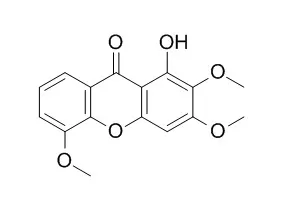| In vitro: |
| Life Sci. 2007 Sep 1;81(12):1016-23 | | Mechanisms of the vasorelaxant effect of 1-hydroxy-2, 3, 5-trimethoxy-xanthone, isolated from a Tibetan herb, Halenia elliptica, on rat coronary artery.[Pubmed: 17822718] | 1-Hydroxy-2,3,5-trimethoxyxanthone(HM-1) is a xanthone isolated from Halenia elliptica, a Tibetan medicinal herb.
METHODS AND RESULTS:
HM-1 (0.33-42.1 microM) produced a concentration-dependent relaxation in rat coronary artery rings pre-contracted with 1 microM 5-hydroxytryptamine (5-HT), with an EC(50) of 1.67+/-0.27 microM. Removal of the endothelium significantly affected the vasodilator potency of HM-1, resulting in 46% decrease in E(max) value. The endothelium-dependent effects of HM-1 was confirmed when its vasorelaxant effect was inhibited after addition of nitric oxide synthase (NOS) inhibitor N(omega)-nitro-l-arginine methyl ester (100 microM) or the soluble guanylate cyclase inhibitor 1H-[1, 2, 4] oxadiazolo [4,3-alpha] quinoxalin-1-one (ODQ, 10 microM). Atropine (100 nM), flurbiprofen (10 microM), propranolol (100 microM), pyrilamine (10 microM), cimetidine (10 microM) and SQ22536 (100 microM) had no effect on the vasorelaxant activity of HM-1 indicated the non-involvement of other receptor/enzyme systems. In endothelium-denuded coronary artery rings, the vasorelaxant effect of HM-1 was unaffected by potassium channel blockers such as tetraethylammonium (10 mM), iberiotoxin (100 nM), barium chloride (100 microM) and 4-aminopyridine (1 mM). The involvement of Ca(2+) channel in 5-HT-primed artery ring preparations incubated with Ca(2+)-free buffer was confirmed when HM-1 (9.93 microM) partially abolished the CaCl(2)-induced vasoconstriction (87% inhibition in intact-endothelium artery rings; 50% inhibition in endothelium-denuded rings). In the KCl-primed preparations incubated with Ca(2+)-free buffer, HM-1 (9.93 microM) produced a 27.3% inhibition in endothelium-denuded rings. HM-1 (3.31-33.1 microM) had minimal relaxant effects (14.4%-20.3%) on the contractile response generated by 10 microM phorbol 12,13-diacetate (PDA) in Ca(2+)-free solutions, suggesting minimal effects on intracellular Ca(2+) mechanisms.
CONCLUSIONS:
These findings suggest the vasodilator action of HM-1 involved both an endothelium-dependent mechanism involving NO and an endothelium-independent mechanism by inhibiting Ca(2+) influx through L-type voltage-operated Ca(2+) channels; a minor contribution to the effects of HM-1 may be related to inhibition of the protein kinase C-mediated release of intracellular Ca(2+) stores. | | Arch Pharm Res. 2008 Jul;31(7):850-5. | | Inhibitors of bone resorption from Halenia corniculata.[Pubmed: 18704326] |
METHODS AND RESULTS:
Eleven xanthones (1-11), three flavonoids (12-14) and three secoiridoids (15-17) were isolated from the aerial parts of Halenia corniculata.
Among those compounds, 1-hydroxy-2,3,4,5-tetramethoxyxanthone (1), 1-hydroxy-2,3,4,7-tetramethoxyxanthone (2), 1-hydroxy-2,3,4,5,7-pentamethoxyxanthone (3), 1-Hydroxy-2,3,5-trimethoxyxanthone (4), 1,8-dihydroxy-3,5-dimethoxyxanthone (7), and luteolin (12), at the concentration of 1 microg/mL, effectively inhibited the osteoclast differentiation in a co-culture system with mouse osteoblastic calvarial cells and bone marrow cells. Notably, compounds 1, 3, and 4 exhibited, in a dose-dependent manner, significant inhibition of osteoclast differentiation even at a low concentration (0.01 microg/mL). All the inhibitory compounds, except for compound 7, significantly reduced the pit formation on the dentine slice compared with the control group.
CONCLUSIONS:
For the survival of the mature osteoclasts, compounds 1-4 and 12 (1 microg/mL), significantly decreased the survival number through induction of cell apoptosis, and compound 4 exhibited a significant inhibitory effect on osteoclast survival even at the low concentration of 0.1 microg/mL. |
|






 Cell. 2018 Jan 11;172(1-2):249-261.e12. doi: 10.1016/j.cell.2017.12.019.IF=36.216(2019)
Cell. 2018 Jan 11;172(1-2):249-261.e12. doi: 10.1016/j.cell.2017.12.019.IF=36.216(2019) Cell Metab. 2020 Mar 3;31(3):534-548.e5. doi: 10.1016/j.cmet.2020.01.002.IF=22.415(2019)
Cell Metab. 2020 Mar 3;31(3):534-548.e5. doi: 10.1016/j.cmet.2020.01.002.IF=22.415(2019) Mol Cell. 2017 Nov 16;68(4):673-685.e6. doi: 10.1016/j.molcel.2017.10.022.IF=14.548(2019)
Mol Cell. 2017 Nov 16;68(4):673-685.e6. doi: 10.1016/j.molcel.2017.10.022.IF=14.548(2019)